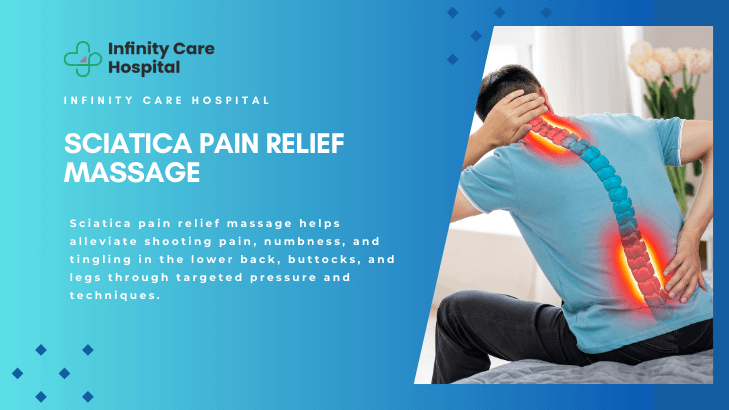Did you know that a staggering 40% of people will experience sciatica at some point in their lives? This debilitating condition can be extremely painful and may even prevent you from performing your daily activities if the discomfort becomes too much. However, massage is an effective way to ease pressure on the sciatic nerve and reduce pain from sciatica. While it may not cure sciatica permanently, it is often recommended before trying medical treatments like steroid injections for sciatica. This article will provide an overview of sciatica pain relief massage, including the benefits, techniques, and massage points for relieving sciatic discomfort.
### Key Takeaways
– Sciatica pain relief massage can effectively reduce discomfort and pressure on the sciatic nerve – Massage techniques like deep tissue, Swedish, neuromuscular, and myofascial release can target specific pressure points
– Self-massage using tools like tennis balls and foam rollers can supplement professional massage therapy
– It’s important to choose a qualified, experienced massage therapist who specializes in treating sciatica
– Massage should be combined with other complementary therapies for a comprehensive approach to managing sciatica
Understanding Sciatica
Sciatica is a medical term that refers to pain along the sciatic nerve, which is the longest and widest nerve in the body. It runs along the lower spine, through the pelvic region, and down to each leg. The sciatic nerve supplies both motor control and nerve sensation, and due to this, sciatica can cause muscle weakness and nerve pain in the body.
Causes of Sciatica
The most common cause of sciatica is a slipped or herniated disc, where a force pushes all or part of the disc through a weaker part of the spine, putting pressure on the sciatic nerve. Other possible causes include spinal stenosis, piriformis syndrome, pelvic injury or fracture, and in rare cases, tumors or spondylolisthesis.
Symptoms of Sciatica
Symptoms of sciatica typically include shooting pain, numbness, tingling, and weakness in the lower back, buttocks, and legs.
Benefits of Massage for Sciatica Pain Relief
Massage therapy can be highly beneficial for individuals suffering from sciatica-related muscle and nerve pain. One of the primary benefits of massage is its ability to promote muscle relaxation. During a massage session, the body releases endorphins, which are natural pain-relieving chemicals that can help alleviate the discomfort associated with sciatica.
In addition to muscle relaxation, massage can also improve circulation throughout the body, including the lymphatic system. Enhanced circulation helps bring fresh, oxygenated blood to the affected areas, promoting healing and reducing inflammation. This increased blood flow can be particularly helpful in addressing the underlying causes of sciatica, such as tight or spasming muscles.
Another key benefit of massage for sciatica is the release of endorphins. Endorphins are the body’s natural painkillers, and their release during a massage session can help manage the pain and discomfort experienced by individuals with sciatica. This endorphin release can also induce a sense of relaxation and well-being, further contributing to the overall pain relief and improved quality of life.
While there is no conclusive evidence that one specific massage technique is more effective than others for sciatica pain relief, it is important to work with a registered massage therapist (RMT) who can assess your individual needs and recommend the most appropriate approach. By incorporating the benefits of muscle relaxation, improved circulation, and endorphin release, massage can be a valuable tool in your journey towards managing and reducing sciatica-related discomfort.
sciatica pain relief massage Techniques
When it comes to providing relief from sciatica pain, massage therapists have several techniques at their disposal. By targeting the specific muscles, connective tissues, and trigger points affected by this condition, they can help alleviate discomfort and promote healing. Some of the most effective sciatica massage techniques include:
Deep Tissue Massage
Deep tissue massage focuses on massaging the deep layers of muscles and the connective tissues around the muscles. This technique has been shown to help improve chronic pain, including sciatica, by applying slow and even pressure to lengthen and relax the tissue.
Swedish Massage
Swedish massage uses flowing, kneading movements to stimulate nerve endings in the connective tissue and increase blood flow, helping to release general tension and promote relaxation. This can be beneficial for those experiencing sciatica-related discomfort.
Neuromuscular Massage
Neuromuscular massage combines deep tissue pressure and friction to release contracted muscles and relieve tension. By targeting specific trigger points and areas of tightness, this technique can help alleviate the symptoms of sciatica.
Myofascial Release
Myofascial release is a technique used to relieve pain that stems from the myofascial tissues, the tough membrane that surrounds and supports the muscles. It focuses on releasing trigger points, which are stiff, immovable areas within the myofascial tissues, to reduce pain and stiffness.
Massage Points for Sciatica Relief
When providing a massage to alleviate sciatica pain, it’s crucial to concentrate on specific pressure points in the glutes, hamstrings and thighs, and calves. The glutes, including the gluteus maximus, gluteus medius, gluteus minimus, and the piriformis, are key areas to target during the massage points for sciatica. The hamstrings, iliotibial (IT) tract, and hip rotators in the thighs are also important massage points to address.
Glutes
The glute muscles, such as the gluteus maximus, gluteus medius, and gluteus minimus, are crucial areas to focus on during a glutes massage for sciatica relief. The piriformis muscle, located deep within the glutes, can also contribute to sciatic nerve pain and should be treated with care.
Hamstrings and Thighs
The hamstring massage and treatment of the thigh massage areas, including the iliotibial (IT) tract and hip rotators, can also provide significant relief for sciatica sufferers. Targeting these muscle groups can help release tension and improve circulation in the affected areas.
Calves
In addition to the glutes and thighs, the calf massage is an important consideration for sciatica pain relief. The soleus and gastrocnemius muscles in the calves should be addressed to promote relaxation and reduce discomfort.
It’s important to avoid applying direct pressure on the sciatic nerve itself or any of the nerves that stem from it, as this can further irritate the nerve and exacerbate the pain. A skilled and experienced massage therapist can help identify the appropriate massage points and techniques to effectively manage sciatica symptoms.
Massage Techniques for Sciatica Pain Relief
There are several effective sciatica massage techniques that can be used to provide relief for sciatica pain. These include myofascial release, which helps identify and release areas of stiffness around the sciatic nerve; sacrum pressure relief, which stretches and separates the gluteus maximus muscle; gluteus minimus massage, which targets this muscle that can contribute to sciatica-like discomfort.
The massage for sciatica pain relief also includes techniques like greater trochanter elbow glide, which releases tension in the deeper tissues around the hip; gluteus maximus petrissage, a kneading technique that warms up the glute muscles; manual knee manipulation and glute/hamstring massage, which combines joint movement with muscle work; and soleus and gastrocnemius thumb massage, which targets the lower leg muscles without putting pressure on the sciatic nerve.
Self-Massage for Sciatica
If you’re unable to receive professional massage therapy or simply want to supplement it with at-home care, there are several self-massage techniques you can try for sciatica relief. Using a tennis ball can work similarly to trigger point therapy – by pressing and rolling the tennis ball over areas of tension, you can slowly relax and release the tightness of the surrounding muscles. A foam roller can also be used to massage the IT band, glutes, and other areas affected by sciatica. These self-massage tools can be a convenient and cost-effective way to manage sciatica pain at home.
Tennis Ball Massage
The tennis ball massage technique involves using a tennis ball to target specific pressure points and areas of tension around the sciatic nerve. By rolling the tennis ball over the affected muscles, you can apply targeted pressure to help release tightness and promote circulation. This self-massage method can be particularly helpful for addressing knots and trigger points in the glutes, piriformis, and hamstring muscles.
Foam Roller Massage
A foam roller is another effective tool for self-massage for sciatica. By placing the foam roller under the affected areas, such as the IT band, glutes, or hamstrings, and applying gentle pressure, you can help release muscle tension and increase mobility in the joints and soft tissues. The rolling motion of the foam roller can also improve circulation and reduce inflammation around the sciatic nerve.
Incorporating these self-massage techniques into your sciatica management routine can provide a convenient and cost-effective way to supplement professional massage therapy and help alleviate your symptoms from the comfort of your own home.
Choosing a Massage Therapist
If you’re interested in trying massage for sciatica relief, it’s important to choose a qualified and experienced massage therapist. Look for a licensed, registered massage therapist (RMT) who has specific experience treating sciatica symptoms. When researching massage therapists, consider factors like their credentials, the types of massage they specialize in, their level of experience with sciatica, and whether they accept your health insurance.
Qualifications
A qualified massage therapist should hold a license or certification from a recognized governing body, such as the American Massage Therapy Association (AMTA) or the National Certification Board for Therapeutic Massage and Bodywork (NCBTMB). These credentials ensure the therapist has undergone comprehensive training and adheres to professional standards of practice.
Experience with Sciatica
When choosing a massage therapist, it’s crucial to find one who has specific experience treating sciatica. Ask about the types of massage techniques they use for sciatica relief, such as deep tissue, neuromuscular, or myofascial release. Inquire about their success in managing sciatica symptoms and their approach to working with clients who have this condition.
It’s also a good idea to have an open conversation with the therapist about your sciatica symptoms and any other health conditions you have before your first session. This will help ensure the massage is safe and effective for your specific needs.
Precautions and Contraindications
While sciatica massage can be an effective way to manage sciatica pain, there are some sciatica massage precautions and sciatica massage contraindications to be aware of. Massage should be avoided in certain situations, such as during an acute sciatica flare-up, if there is any numbness or tingling in the leg, or if the pain is accompanied by bowel or bladder dysfunction, which could indicate a more serious condition. Massage may also not be recommended for pregnant women, as certain pressure points should be avoided.
It’s important to communicate openly with your massage therapist about your symptoms and any other health concerns you have to ensure the massage is safe and beneficial for your specific condition.
| Precautions for Sciatica Massage | Contraindications for Sciatica Massage |
|---|---|
|
|
By communicating openly with your massage therapist and following their guidance, you can ensure that your sciatica massage is both safe and effective in providing relief for your symptoms.
Complementary Therapies for Sciatica
While massage can be a valuable tool for managing sciatica pain, it may not be the only solution. Some people may also benefit from a combination of massage and other complementary therapies for sciatica.
Physical Therapy
Physical therapy for sciatica can provide activities and exercises that work to relieve discomfort caused by this condition. A physical therapist can develop a personalized treatment plan to address the underlying causes of your sciatica and help reduce pain and improve mobility.
Stretching and Exercises
Sciatica stretches and exercises targeting the muscles and joints affected by this condition can also help alleviate symptoms. Stretching the hamstrings, piriformis, and other hip rotator muscles can take pressure off the sciatic nerve, while strengthening the core and stabilizing the spine can provide additional support. Speaking with your healthcare provider or a physical therapist can help determine the best treatment plan, which may include a combination of massage, physical therapy, and at-home exercises and stretches.
Sciatica Pain Relief Massage Near Me
If you’re seeking sciatica pain relief through massage therapy, you can search for qualified massage therapists in your local area. Look for registered massage therapists (RMTs) who have experience treating sciatica and are licensed to practice in your state. You can search databases like the American Massage Therapy Association or the National Certification Board for Therapeutic Massage & Bodywork to find sciatica pain relief massage near you. When booking an appointment, be sure to communicate your specific sciatica symptoms and any other health conditions you have so the therapist can provide the most effective and safe treatment.
Conclusion
Sciatica can be a debilitating condition, but massage therapy can be an effective way to provide relief from the shooting pain, numbness, and tingling associated with this condition. By targeting specific pressure points and using techniques like deep tissue massage, Swedish massage, neuromuscular massage, and myofascial release, massage therapists can help relax tense muscles, improve circulation, and promote the release of endorphins to alleviate sciatica pain relief symptoms.
While massage for sciatica may not cure sciatica permanently, it can be a valuable part of a comprehensive treatment plan that also includes other complementary therapies like physical therapy and targeted exercises. With the help of a qualified massage therapist, you can find sciatica pain relief and improved quality of life.
By incorporating sciatica pain relief massage into your overall treatment approach, you can take a proactive step towards managing the discomfort and disruption caused by this condition. Whether you opt for a professional massage session or explore self-massage techniques, the benefits of this modality can provide meaningful relief and support your journey towards better health and well-being.
FAQ
What is sciatica?
Sciatica is a medical term that refers to pain along the sciatic nerve, which is the longest and widest nerve in the body. It runs along the lower spine, through the pelvic region, and down to each leg.
What are the common causes of sciatica?
The most common cause of sciatica is a slipped or herniated disc, where a force pushes all or part of the disc through a weaker part of the spine, putting pressure on the sciatic nerve. Other possible causes include spinal stenosis, piriformis syndrome, pelvic injury or fracture, and in rare cases, tumors or spondylolisthesis.
What are the symptoms of sciatica?
Symptoms of sciatica typically include shooting pain, numbness, tingling, and weakness in the lower back, buttocks, and legs.
How can massage help relieve sciatica pain?
Massage therapy can be beneficial for sciatica-related muscle and nerve pain. During massages, you feel a sense of relaxation due to the release of endorphins, which help relieve pain and heighten pleasure. Massage can also increase circulation, not just blood circulation but all fluids in the body, including the lymphatic system.
What are some effective massage techniques for sciatica pain relief?
Different massage techniques can help release tension and pain in the body from sciatica, including deep tissue massage, Swedish massage, neuromuscular massage, and myofascial release.
What are the key pressure points for sciatica massage?
When giving a massage to relieve sciatica pain, it’s important to focus on specific pressure points in the glutes, hamstrings and thighs, and calves.
Can I do self-massage for sciatica relief?
Yes, there are several self-massage techniques you can try for sciatica relief, such as using a tennis ball or foam roller to massage the affected areas.
What should I look for when choosing a massage therapist for sciatica?
When researching massage therapists, consider factors like their credentials, the types of massage they specialize in, their level of experience with sciatica, and whether they accept your health insurance.
Are there any precautions or contraindications for sciatica massage?
Massage should be avoided in certain situations, such as during an acute sciatica flare-up, if there is any numbness or tingling in the leg, or if the pain is accompanied by bowel or bladder dysfunction. Massage may also not be recommended for pregnant women.
Can massage be combined with other therapies for sciatica relief?
Yes, some people may benefit from a combination of massage and other complementary therapies, such as physical therapy, stretching, and strengthening exercises.




